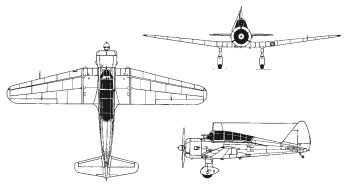



The Tachikawa Ki-36 'Ida' was a relatively unknown army co-operation monoplane which was produced in large numbers and featured prominently in many of the earlier campaigns in the Pacific. Its principal feature was the ability to operate from rough airsprits close to or even behind the battle lines, it also had excellent pilot and observer visibility which was aided by swept back leading edges of the wings and the inclusion of windows under the wing center sections. Ki-36s were immediately deployed to China where it was considerably successful but they found greater difficulties in the face of heavier fighter opposition after the outbreak of the Pacific War. It was eventually developed into an advanced trainer and also operated by the puppet states of Cochin China, Manchukuo and Thailand with some abandoned examples being used by Indonesia post-war.
The Ki-36 was born out of a 1937 Army requirement and the prototype performed its maiden flight on 20 April 1938. There was no other major version of this aircraft aside from the Ki-55 advanced trainer, also code named 'Ida' by the Allies, which included a number of weight-reduction features such as removal of the rear gun and wheel spats.
Preceded by:
NoneSucceeded by:
None | |
| Design | Ki-36 |
| Code Name | Ida |
| Type | Close Support |
| Year | 1938 |
| Crew | 2 |
| Dimensions | |
| Length | 8 m |
| Height | 3.640 m |
| Wing Span | 11.80 m |
| Wing Area | n/a |
| Weight | |
| Empty | 1,247 kg |
| Maximum | 1,660 kg |
| Wing Loading | 83 kg/m² |
| Performance | |
| Speed | 347 km/h |
| Ceiling | 8,200 m |
| Range | 1,060 km |
| Powerplant | |
| Engine | 1 x Ha-13a Hitachi 380 kW |
| Thrust/Weight | 0.37 |
| Armament | |
| Guns | 2 x 7.7-mm |
| Payload | 150 kg |
| Production | |
| Built | 1,334 |
| Total | 2,723 |